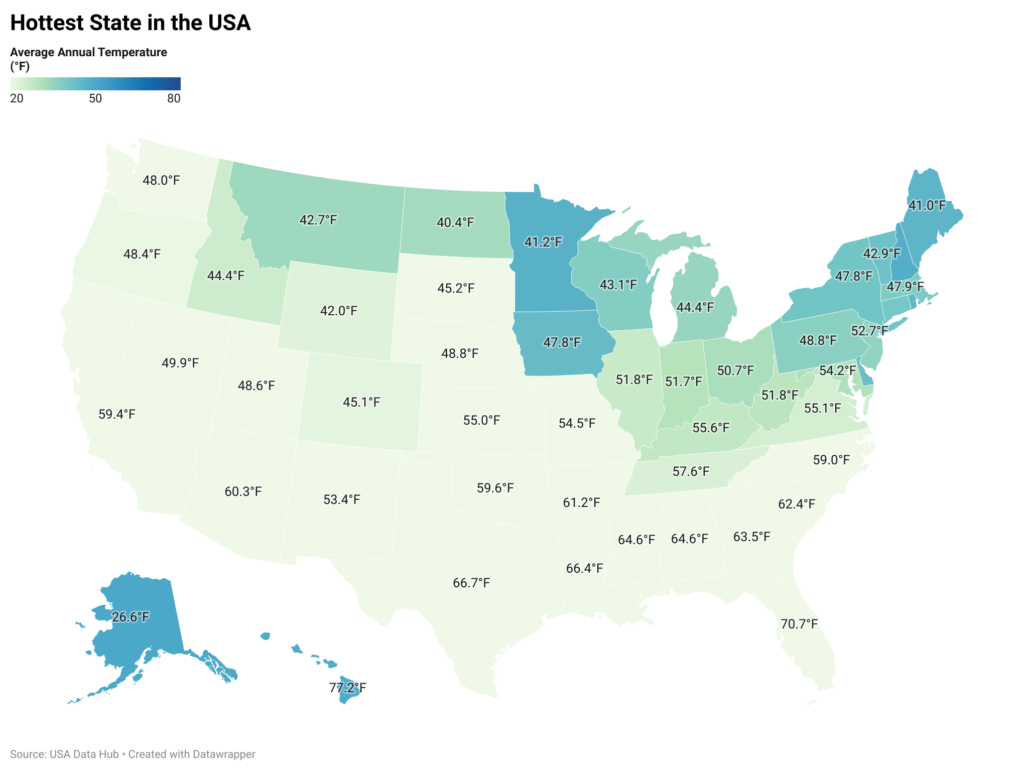America's Scorching Secrets: Unveiling The Hottest States In The US
The United States of America is a land of incredible diversity, not just in its cultures and landscapes, but also in its climates. From the frozen tundra of Alaska to the sweltering everglades of Florida, the country experiences a vast range of temperatures throughout the year. However, some states consistently stand out for their exceptionally high temperatures, earning them the distinction of being the hottest states in America. But what exactly makes a state "hot," and which ones truly top the list?
Understanding the nuances of temperature goes beyond just a single mercury reading. When we talk about the hottest states in the US, we delve into a combination of factors: average annual temperatures, humidity levels, geographical features, and even seasonal variations. This comprehensive exploration will reveal which states truly experience the highest heat, backed by reliable data from authoritative sources like the National Oceanic and Atmospheric Administration (NOAA), helping you discover the hottest states in the U.S. and why they consistently rank at the top.
Table of Contents:
- Xxxxxx Is Equal To 2
- Ssis 469
- Soviet Seduction Jackerman
- Sophie B Hawkins Husband
- All Uncut Web Series Download
- Understanding the Heat: What Makes a State "Hot"?
- The Reigning Champions: Hottest States by Average Annual Temperature
- Beyond Averages: Peak Temperatures and Record Breakers
- Regional Climates and Geographical Influences
- The Role of Humidity: More Than Just Temperature
- Looking Ahead: Hottest States in 2025 and Beyond
- Living with the Heat: Adapting to America's Warmest Regions
- Conclusion: Embracing the Heat of the US
Understanding the Heat: What Makes a State "Hot"?
When we discuss the "hottest state in the US," it's crucial to define what metrics we're using. Is it the highest recorded temperature ever? Or is it the consistent, year-round warmth? For the purpose of identifying the hottest states, meteorologists and climate scientists typically rely on the mean annual temperature. This metric is the average of the twelve monthly average temperatures for each state, providing a comprehensive picture of a state's overall warmth throughout the year. It accounts for both summer highs and winter lows, giving a truer sense of the climatic features. Several factors contribute to a state's high average temperature. Geographical location plays a monumental role; states closer to the equator generally receive more direct sunlight. Proximity to large bodies of water, like the Gulf of Mexico, can introduce significant humidity, making the perceived temperature (or "feels like" temperature) much higher, even if the actual air temperature is not at its absolute peak. Topography also matters; flat landscapes can allow heat to spread unhindered, while mountainous regions might offer cooler elevations. Additionally, prevailing wind patterns and the presence of arid deserts or humid coastlines all play a part in shaping a state's thermal profile. These climatic features are what differentiate the heat of one state from another, from Florida's humid warmth to Arizona's dry scorching sun.The Reigning Champions: Hottest States by Average Annual Temperature
According to data from the National Oceanic and Atmospheric Administration (NOAA), which meticulously tracks climate trends across the nation, we can confidently identify which states consistently experience the highest average temperatures. These are the states where intense summer heat is no stranger, and even the cooler months remain remarkably mild compared to the rest of the country. For instance, in 2023, with Hawaii, Florida, and Texas leading, the picture of America's warmest regions became clear. Based on data from the National Oceanic and Atmospheric Administration, these were the 10 hottest states in 2024, ranked by highest statewide average temperature from January to December.Florida: The Sunshine State's Scorching Reality
When it comes to the hottest states in the US, Florida consistently tops the list. Florida is the hottest state with an average temperature of 71.5°F (21.9°C). Another source even cites Florida as the hottest state in the US with an average temperature of 72.5°F (22.5°C). This makes Florida approximately 19°F warmer than the US's average temperature of 53°F (11.7°C). This remarkable warmth isn't just a summer phenomenon; Florida ranks overall as the warmest state year-round. The reasons for Florida's perpetual heat are multifaceted. Its geographical location, extending deep into the subtropical and tropical zones, means it receives abundant solar radiation throughout the year. The state is almost entirely surrounded by water – the Atlantic Ocean to the east and the Gulf of Mexico to the west – which contributes to extremely high humidity levels. This humidity traps heat, making already warm temperatures feel even more oppressive. The flat landscape, particularly the vast Everglades, also allows heat to settle and intensify. Cities like Miami, Tampa, and Orlando experience long, hot, and humid summers, with mild, short winters that rarely see freezing temperatures. This consistent warmth is a defining climatic feature of the Sunshine State, making it the quintessential hottest state.Texas: A Vast Landscape of Intense Heat
Following closely behind Florida, Texas is another prominent contender for the title of the hottest state in the US. Full of diverse cultures, cities, and cuisines, Texas is the hottest state in the U.S. in terms of sheer geographical expanse experiencing extreme heat. Texas is so hot largely because of its flat landscape, most notably the Gulf Coast in the south, the Chihuahuan Desert to the west, and the Great Plains throughout. The sheer size of Texas means it encompasses several distinct climatic zones, many of which are characterized by intense heat. The Gulf Coast region, similar to Florida, experiences high humidity and oppressive summer temperatures due to its proximity to the Gulf of Mexico. Cities like Houston and Corpus Christi are known for their steamy summers. Moving westward, the climate transitions into a more arid, desert environment, particularly in areas bordering the Chihuahuan Desert. Here, cities like El Paso experience scorching dry heat, with temperatures frequently soaring well above 100°F (38°C) during the summer months. The vast, flat plains in the central and northern parts of the state also contribute to high temperatures, as there are few natural barriers to block solar radiation or provide cooling effects. This combination of humid coastal areas, arid deserts, and expansive plains makes Texas a consistently hot state with diverse manifestations of its heat.Arizona: The Desert's Fiery Embrace
Arizona is synonymous with scorching temperatures, especially in its major cities like Phoenix and Tucson. The state experiences high temperatures that are often dry, a stark contrast to the humid heat of Florida or the Texas coast. This arid heat is a defining characteristic of Arizona's climate. The primary reason for Arizona's extreme heat is its location within the Sonoran Desert. Deserts are characterized by minimal cloud cover and low humidity, which allows the sun's rays to directly heat the ground and air. During the day, temperatures can skyrocket, with Phoenix regularly ranking as one of the hottest major cities in the world. While desert nights can bring some relief as heat radiates quickly into the clear sky, the average daily temperatures remain exceptionally high. The state's geographical features, including vast stretches of flat, sandy terrain and sparse vegetation, contribute to this intense solar absorption and heat retention. Learning about the climatic features, factors, and seasons of these states, from Florida to Arizona, reveals the unique ways in which heat manifests across the US.Other Notable Contenders in the Heat Stakes
While Florida, Texas, and Arizona often dominate the discussion of the hottest states, several other states consistently rank high due to their unique climatic features and geographical positions. These states, primarily located in the southern parts of the country, experience significant heat for various reasons: * **Louisiana:** Following Florida, Louisiana is another state known for its oppressive humidity and high average temperatures. Its location on the Gulf Coast means it shares many climatic characteristics with southern Texas and Florida, including long, hot, and extremely humid summers. * **Hawaii:** Although often perceived as a tropical paradise, Hawaii consistently ranks among the warmest states due to its equatorial proximity. While its island nature moderates extreme highs, its year-round average temperatures are very high, making it a consistently warm destination. * **Mississippi and Alabama:** These Deep South states, also bordering the Gulf of Mexico, share similar climatic features with Louisiana and Florida. They experience long, hot, and humid summers, contributing to high annual average temperatures. * **Nevada:** Similar to Arizona, much of Nevada is covered by desert landscapes, particularly the Mojave Desert. This leads to extremely hot and dry summers, especially in cities like Las Vegas. * **California:** While California is incredibly diverse climatically, its southern and interior regions, including the Central Valley and areas bordering the Mojave Desert, experience significant heat. Death Valley, located in eastern California, holds the record for the highest air temperature ever recorded on Earth. * **New Mexico:** Sharing borders with Texas and Arizona, New Mexico also experiences a predominantly arid climate with hot summers, particularly in its southern and eastern plains. These states, along with others in the Sun Belt, collectively contribute to the understanding of the hottest states in America. The list of average temperatures for each American state during summer (June, July, and August) further solidifies their positions at the top.Beyond Averages: Peak Temperatures and Record Breakers
While average annual temperatures provide a good baseline for identifying the hottest states, it's also worth noting the extreme highs that many states experience. Intense summer heat is no stranger in the United States, and all 50 states have recorded a high temperature of at least 100 degrees Fahrenheit (37.8°C), with many well above 115°F (46.1°C). This highlights that even states not typically considered "hot" can experience brief, but severe, heatwaves. For instance, the highest temperatures are often recorded in desert regions. California's Death Valley holds the world record for the highest air temperature ever recorded, a staggering 134°F (56.7°C) on July 10, 1913. While this is an extreme outlier, it underscores the potential for monumental heat in certain geographical pockets. Arizona's Phoenix regularly sees summer temperatures exceed 110°F (43.3°C) for extended periods. Even states further north can experience spikes; for example, states like Oklahoma and Kansas, part of the Great Plains, can see temperatures soar into the 110s during severe heatwaves, driven by continental air masses and clear skies. Discover the hottest states in the U.S. by looking at both their consistent warmth and their capacity for extreme temperature records.Regional Climates and Geographical Influences
The United States of America is massive and is home to various climates. These variations are a result of the country’s vast size and diverse geography. From chilly northern regions to tropical coastlines, the country experiences a wide range of temperatures throughout the year. Most of the hottest states are located in the southern parts of the country, often referred to as the "Sun Belt." This region benefits from its lower latitude, receiving more direct sunlight throughout the year. Beyond latitude, specific geographical features play a crucial role: * **Coastal Proximity:** States bordering the Gulf of Mexico (Florida, Louisiana, Texas, Mississippi, Alabama) experience a maritime tropical climate characterized by high temperatures and significant humidity. The warm waters of the Gulf act as a heat sink, keeping air temperatures elevated. * **Desert Environments:** States in the Southwest (Arizona, Nevada, parts of California, New Mexico, Texas) are dominated by arid and semi-arid climates. The lack of moisture in the air means that temperatures can rise very high during the day due to intense solar radiation, though they often cool significantly at night. * **Flat Plains:** The expansive, flat landscapes of states like Texas and Oklahoma allow for the unimpeded flow of hot air masses, and without significant elevation changes or large bodies of water to moderate temperatures, heat can build up intensely. * **Mountain Ranges:** While not contributing to heat, mountain ranges like the Rockies can create rain shadows, leading to arid conditions on their leeward sides, which in turn can contribute to higher temperatures in those specific areas (e.g., eastern Washington, parts of Colorado). Understanding these regional climates and geographical influences is key to comprehending why certain states consistently rank as the hottest states in the US.The Role of Humidity: More Than Just Temperature
When considering the hottest states in the US, the discussion often goes beyond just the numerical temperature reading to include humidity levels. Humidity significantly impacts how heat is perceived by the human body. High humidity makes it harder for sweat to evaporate from the skin, which is the body's natural cooling mechanism. This leads to a "feels like" temperature, or heat index, that can be substantially higher than the actual air temperature. States like Florida, Louisiana, and the coastal regions of Texas are prime examples where humidity plays a massive role in the discomfort of the heat. Even if the air temperature is 90°F (32.2°C), a high humidity level can make it feel like 105°F (40.6°C) or more. This is why the "hottest state" can sometimes be a subjective experience. While Arizona's dry heat might register higher on a thermometer, the humid heat of the Gulf Coast states can feel more oppressive and dangerous due to the body's inability to cool itself efficiently. When it comes to the hottest states in the US, there are several factors to consider such as average temperature, humidity levels, and overall climate. In this article, we explore the top states based on these factors.Looking Ahead: Hottest States in 2025 and Beyond
Climate change is an undeniable factor influencing temperature trends globally, and the United States is no exception. As global temperatures continue to rise, the likelihood of more frequent and intense heatwaves in already warm regions increases. Discover the hottest states in America for 2025, ranked based on climate and temperature trends, suggests an ongoing pattern where the current top contenders are likely to remain so, potentially experiencing even higher average temperatures and more extreme heat events. Scientific projections indicate that states in the Southwest and Southeast, already experiencing significant heat, will likely see an increase in the number of days above extreme temperature thresholds. This means that while Florida might remain the hottest state by average annual temperature, states like Arizona and Texas could experience more prolonged periods of record-breaking dry heat. Understanding these trends is crucial for urban planning, resource management (especially water and energy), and public health initiatives in these increasingly warm regions. The data compiled from various sources, including the National Oceanic and Atmospheric Administration, provides a grim but necessary outlook on future temperature patterns across the nation.Living with the Heat: Adapting to America's Warmest Regions
Life in the hottest states in the US requires a certain level of adaptation. Residents in places like Florida, Texas, and Arizona have developed unique ways of coping with and even embracing the intense heat. Architecture in these regions often features lighter colors, reflective roofs, and designs that maximize shade and airflow. Air conditioning is not merely a luxury but a necessity, deeply integrated into homes, businesses, and transportation. Outdoor activities often shift to early mornings or late evenings to avoid the peak heat of the day. Water sports, swimming pools, and indoor entertainment venues become popular retreats. The culture itself often reflects the climate, with a more relaxed pace during the hottest hours and a vibrant nightlife once temperatures cool. From the laid-back beach culture of Florida to the desert resilience of Arizona, and the expansive, diverse lifestyle of Texas, each of these hottest states offers a unique way of life shaped by its climate. Understanding these adaptations provides insight into how communities thrive despite consistently high temperatures.Conclusion: Embracing the Heat of the US
From the consistently warm and humid embrace of Florida to the vast, scorching landscapes of Texas and the intensely arid heat of Arizona, the United States is home to some truly hot states. These states, primarily located in the southern parts of the country, owe their high average annual temperatures to a combination of geographical factors, climatic features, and seasonal patterns. Data from authoritative sources like NOAA consistently confirms their status as the hottest states in the US, providing a clear picture of where the mercury consistently climbs highest. Whether you're planning a visit, considering a move, or simply curious about the nation's diverse climates, understanding what makes these regions so hot is fascinating. The interplay of latitude, proximity to water, topography, and humidity creates a unique thermal signature for each. As climate trends continue to evolve, these states will likely remain at the forefront of the discussion about America's warmest regions. What are your experiences with the heat in these states? Do you live in one of the hottest states, and how do you cope with the temperatures? Share your thoughts and insights in the comments below! If you found this article informative, please consider sharing it with others or exploring more of our content on climate and geographical features across the United States.
Hottest State In The USA - USA Data Hub

The Hottest State The Hottest State Year: 2006 - USA Michelle Williams

The Hottest State The Hottest State Year: 2006 - USA Mark Webber